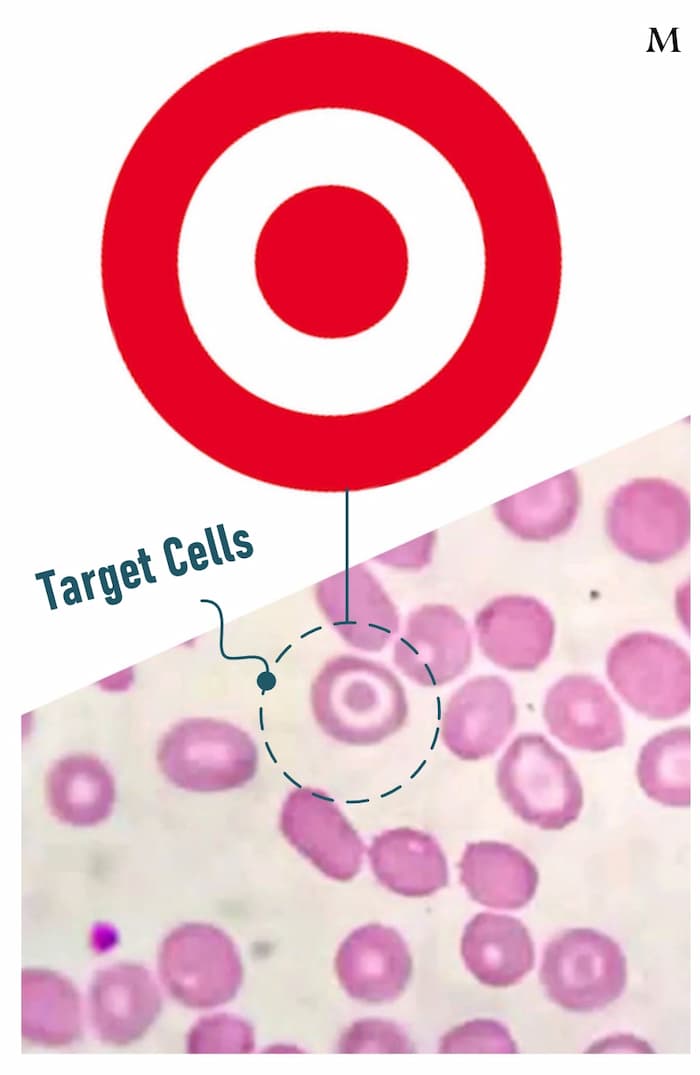Summary :
Target cells are red blood cells shaped like a cup or a bullseye. It provides useful information on many clinical conditions. This blog post will define target cells, describe detection methods, and explore their clinical importance.
◉ What are Target cells ?
Target cells, also known as codocytes or leptocytes, is a unique morphology of red blood cells characterized by a central, round hemoglobin area surrounded by a rim of paler staining.
This distinctive appearance is caused by an increased surface-to-volume ratio of the RBCs due to excess membrane or decreased hemoglobin content. Consequently, the cell membrane forms an abnormal central pallor or "target" within the cell.
They can be observed under a microscope when examining a peripheral blood smear and are identified based on their specific morphological features.

Target cells
◉ Detection of Target cells
The Target cells detection can be performed using various laboratory methods, including:
◉ Target cells on peripheral blood smears
To make a peripheral blood smear, a thin layer of blood is smeared on a glass slide, stained (Typically with May-Grunwald Giemsa stain (MGG)) and observed under a microscope.
The presence of target cells can be identified based on their characteristic appearance, with a central area of hemoglobin surrounded by a clear ring and an outer rim of hemoglobin.
◉ Automated blood cell analyzers
These analyzers utilize laser-based technology and image analysis algorithms to identify and differentiate abnormal red blood cell morphology.
◉ Other methods
Additional tests, such as osmotic fragility tests or hemoglobin electrophoresis, may also aid in detecting and diagnosing conditions associated with target cells.
◉ Causes and Clinical significance of Target cells
Target cells can be associated with various underlying conditions and diseases. Their presence can provide valuable diagnostic information and guide further investigations. Here are a few examples of the clinical significance of target cells:
- Hepatic disease : it may be observed in individuals with liver diseases, such as obstructive jaundice or chronic liver disease. These conditions alter the lipid composition of the RBC membrane, leading to the appearance of it in peripheral blood smears.
- Hemoglobinopathies : Certain inherited hemoglobin disorders, such as thalassemia and hemoglobin C disease, can result in the presence of a target cell. Thus, this detection in patients with suspected hemoglobinopathies can aid in diagnosing and classifying these disorders.
- Iron Deficiency Anemia : In some cases of iron deficiency anemia, it may be seen due to changes in the red blood cell membrane. The reduced hemoglobin content leads to the target cell's formation as RBCs attempt to compensate for the lack of iron. However, it is important to note that codocyte alone is not specific for iron deficiency anemia and should be interpreted with other clinical and laboratory findings.
- Liver Transplantation : Following liver transplantation, the appearance of codocytes in the peripheral blood smear may indicate the recovery of liver function. Hence, Monitoring leptocytes post-transplantation can assist in evaluating the graft's health and overall patient prognosis.
- Hemolytic Disorders : it can also be seen in various hemolytic disorders, including hereditary spherocytosis and hemolytic anemias. Their presence can indicate the underlying red blood cell abnormalities and contribute to diagnosing and managing these conditions.
It is important to note that leptocytes alone are not diagnostic of a specific condition. Further evaluation, including clinical history, additional laboratory tests, and consultation with a healthcare professional, is necessary to determine the underlying cause.
◉ Conclusion
In conclusion, target cells are unique red blood cells with a characteristic appearance, distinguishable by a central hemoglobin area surrounded by a rim of paler staining. They can be detected through microscopic peripheral blood smear examinations or automated blood cell analyzers. Its presence in blood smears allows for the identification and understanding of various medical conditions, including liver disease, hemoglobinopathies, iron deficiency anemia, liver transplantation outcomes, and hemolytic disorders. By recognizing its clinical significance, healthcare professionals can make informed diagnostic and treatment decisions, contributing to improved patient care and outcomes.